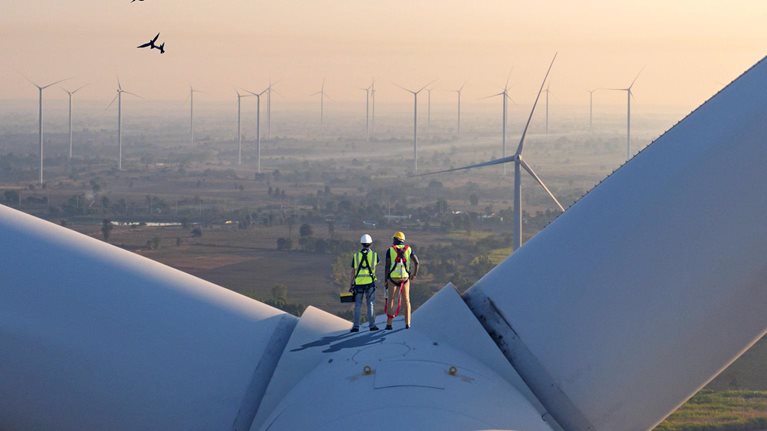The human and financial impacts of natural disasters have been increasing. In 2024, there were 27 “billion dollar climate disasters” in the United States, three times as many as the annual average for the previous 44 years.1 In the first half of 2025 alone, the world experienced more than $162 billion in economic losses from global climate catastrophes.2 The scale of this damage highlights the combined impact of several factors, including the growth of economic exposure in high-climate-risk areas, the changing climate itself, and the limitations of prior investments in resilience and adaptation.
Scientific research on the potential physical hazards of climate change isn’t new, nor is the debate about its causes and practical impacts. What’s new, however, are shifts in market behavior that suggest an increased focus by corporate customers and consumers on building resilience, including managing physical climate risks. These market signals are likely to only intensify going forward as Earth continues to warm. They highlight the growing field of climate resilience, or climate adaptation (we use the terms interchangeably in this article), defined as the “process of adjustment to the actual or expected climate and its effects.”3 While climate mitigation focuses on reducing greenhouse gas emissions, climate resilience encompasses the actions humans can take to prevent or reduce the negative impacts of climate hazards—actions such as building and developing infrastructure, protecting assets, evolving company operations, and shifting economic and consumer activities.
The fundamental objectives of the climate resilience technologies outlined in this article are to enhance and protect lives, livelihoods, and natural resources—objectives that have become even more important in the face of growing climate hazards and their impacts. This changing world requires significant action and investment from leaders across the public and private sectors and also provides the opportunity for investors to create value alongside resiliency benefits. In this article, we examine how markets are changing in response to growing demands. We explore technologies that support climate resilience and provide a framework to help investors consider opportunities in this field.
This article doesn’t intend to size the full scope and need for climate resilience and adaptation, which requires contributions from the public and philanthropic sectors, along with the private sector. Instead, it seeks to examine investment opportunities in areas that will become increasingly more critical due to a changing climate. We also note that the opportunities identified in this article aren’t driven by climate change alone; they’re poised to see support from a range of other factors, such as socioeconomic growth, technological advances, the energy transition, broader risk and resilience concerns, and the greater willingness to pay for resilience across customer segments. The combination of these factors creates an attractive set of opportunities for a range of investors, and the mobilization of private capital into these technologies will further bolster the world’s collective climate resilience.
Evidence of shifting market behavior on climate resilience
As we’ve noted in prior research, throughout history, humanity has long adapted to changes in Earth’s environment through actions such as migration and changes to living or working habits.4 Today, the combination of greater human and economic activity in areas prone to climate hazards, the limitations of prior investments in resilience, and a changing climate is heightening interest in adaptation among individuals, communities, and companies.
In recent years, there’s been growing evidence that executives and investors are increasingly acknowledging the financial risk that climate hazards pose to their assets and are beginning to allocate their attention and capital toward climate resilience. Meanwhile, consumers and corporate customers are also buying more products and services that build resilience against climate risks. One signal of corporations shifting their attention toward climate resilience is the changing language used by major companies in their public communications. We conducted an analysis of public comments across 200 earnings calls, analyst and investor days, and press releases of S&P 500 and STOXX Europe 600 companies and found that mentions of climate-resilience-related terms increased 55 percent from 2021 to 2025.
Financial stakeholders are also responding to the growing focus on climate adaptation. While various instruments tied to severe weather events, such as weather derivatives and catastrophe bonds, have existed for years, we’re seeing more attention and innovation from financial institutions as the frequency and severity of climate risks grow. The insurance industry, for example, has continued to incorporate the evolution of risk into its pricing. This is observed in the Tenants’ and Household Insurance Index (a component of the US Consumer Price Index), which grew three times faster from December 2022 to July 2025 compared with the preceding seven years.
The insurance industry is also starting to implement greater differentiation in its pricing strategy for high-risk customers and geographies. Home insurance premiums increased across all states from 2020 to 2023. During this period in Florida, a state highly vulnerable to hurricanes and flooding, average annual premiums rose by approximately 55 percent, up to $3,500, compounded by the rising costs of insurance claims that exceed general inflation and the resulting increase in legal costs. These increasing insurance costs send pricing signals to policyholders of their risks and are another indicator of the growing importance of investing in resilience.
The growing awareness of climate-related risks is also spurring investments from some homeowners, businesses, and leaders in the public sector. While starting from a small base, we observe several cases of increased spending on resilience-related goods and services across each of the major types of physical hazards: wildfires and severe heat, storms and flooding, and drought and water stress. For instance, consider the adoption of the FORTIFIED standard, a voluntary set of construction and reroofing specifications.5 The number of buildings adopting this standard doubled between 2019 and 2024, with a 30 percent increase between 2023 and 2024 alone (Exhibit 1). The number of new application submissions grew by a record 160 percent during that same period.

In another sign of the shifting market, a US supplier of home standby and portable generators reported an increase in residential sales of 18 percent from 2023 to 2024 in response to elevated outage activity from storms.6 The company expects record sales in 2025. We also observe increased investment activity in technology that supports climate resilience and adaptation in the wake of recent extreme weather events. The January 2025 wildfires in the greater Los Angeles area, for example, caused unprecedented damage and economic loss but also galvanized investment across the value chain for wildfire prevention and management (see sidebar, “The impact of the 2025 wildfires in Southern California”).
Climate resiliency investing: An emerging field at an inflection point
At a broader level, however, the mobilization of private capital into climate resilience technologies is relatively nascent. Historically, development finance groups and public institutions have led the charge, contributing greater than 85 percent of all capital allocated for climate resilience.7 In comparison, 11 percent has come from private capital sources, including 1.5 percent from corporate investors, 3.6 percent from private capital investors, and 5.7 percent from banks (Exhibit 2).

Overall, private capital activity in climate adaptation and resilience has been materially lower compared with investment in decarbonization and mitigation. As of June 2025, less than $8 billion had been raised for investments in resilience from fewer than 120 dedicated climate resilience funds, whereas more than $650 billion had been raised for decarbonization and broader sustainability investments from more than 1,300 private funds.
Although private capital in this area is beginning from a small base, it’s starting to mobilize around climate resilience as an attractive theme. Larger firms are making investments dedicated to adaptation and resiliency, often out of their existing climate funds. This year, alternative asset management firm TPG and private equity firm Renaissance Partners jointly acquired a controlling stake in SICIT, a company focused on biostimulants used in sustainable agriculture and food production. This deal marked TPG Rise Climate’s first investment in the field of climate resilience. In 2024, global investment management firm Invesco launched a new $500 million fund focused on climate adaptation investments in the private and public sectors.
Several specialized investment firms have also launched funds dedicated to climate adaptation. Lightsmith, a climate-resilience-dedicated private equity firm, closed a $186 million growth equity fund in 2022. It has invested in several areas, including off-grid water harvesting, tech-enabled agriculture supply chains, and AI satellite monitoring. Venture capital firm Convective Capital focuses exclusively on investments in wildfire prevention, risk mitigation, suppression, and recovery. In January 2025, it announced that it was raising $75 million for its second fund.
Mapping the landscape for climate resiliency investment opportunities
In the face of a growing need for investment in climate resilience, we developed a framework to map the technologies that support climate resilience and analyzed the potential scale of these growing markets. Climate resilience solutions can be large scale or incremental, short or long term, and direct or indirect. To help potential investors understand concrete opportunities, we sought to quantify the near-term opportunity for private capital, even as we recognize that this is only a part of what’s needed for full adaptation of companies and communities.
For corporate executives and investors of private capital, we estimate technologies that support climate resilience could represent addressable markets worth $600 billion to $1 trillion by 2030. To assess and quantify these opportunities, we used a three-step approach, beginning with a comprehensive mapping of technologies across five types of physical hazards and six types of assets.
Step one: Developing a catalog of adaptation technologies. We began by identifying 200 adaptation technologies that address five areas: wildfires, extreme heat and heatwaves, flooding and storms, drought and water stress, and postdisaster response. We looked at potential sources of near-term demand across six different at-risk asset types: food and agriculture, human health, buildings, energy infrastructure, supply chains, and multiasset resiliency needs. We also estimated demand across households, the public sector, and the private sector.
Through this process, we identified ten technology categories that support climate resilience and adaptation and represent attractive opportunities for investors:
- Building resilience: This category includes technologies and systems that improve the resiliency of buildings against physical climate hazards or reduce buildings’ reliance on volatile resources. Examples include heating, ventilating, and air-conditioning (HVAC) units; heat pumps; and building hardening.
- Grid hardening: Grid-hardening services and solutions protect the grid from climate hazards and improve resilience. Examples include energy storage and smart-grid technology.
- Logistics and supply chain: This category includes storage and transportation equipment for food, pharmaceuticals, and other products that require temperature control. Examples include supply chain software and active containers.
- Water infrastructure: Water technologies, infrastructure, and services can address water scarcity and improve water quality. Examples include wastewater treatment, water meters, desalination, and rainwater harvesting.
- Resilient agriculture: Agriculture software, equipment, and service-based solutions can reduce energy or water consumption, increase yields, and protect harvests against increasingly severe weather conditions. Examples include farm management software and advanced irrigation.
- Healthcare and livelihood: These technologies and products improve health and livelihood conditions in an evolving climate. Examples include health surveillance and warning technology, and remote healthcare services and solutions.
- Disaster prediction, prevention, and recovery: This category of solutions and services can help forecast, manage, and recover from weather-related disasters. Examples include emergency management platforms and weather-forecasting software.
- Wildfire and vegetation management: These solutions, analytics, and services are for wildfire prevention, response, and recovery. Examples include postfire restoration and wildfire analytics.
- Financial-risk transfer: Specialized insurance and data providers can enable a faster and more transparent claims process for hazard damages. Examples include parametric insurance (insurance that pays out when a specific event or condition occurs rather than reimbursing for losses after an event happens) and insurance support services.
- Flood management: Flood management solutions, infrastructure, and services help prevent, reduce, and recover from flood damage. Examples include stormwater and flood software and emergency flood services.
Step two: Identifying a subset of attractive technologies for investors. We then narrowed the scope of technologies to those that could be attractive to investors over the next five years, given their anticipated near-term adoption and addressable market growth. We used the following criteria to prioritize climate resilience technologies for this report:
- Mature solutions: This timeline requires that we focus on relatively mature technologies that have been proved in the field and have the potential to see material adoption by 2030. We also looked for evidence of customer-validated performance and business model maturity, given the current traction of these technologies in the market. This analysis didn’t cover longer-term, larger-scale resiliency levers, such as shifting the time or location of human work and massive infrastructure changes that may also be needed for broader climate adaptation.
- Near-term resiliency benefits: We focused on technologies that could be deployed in a relatively short timeline and were aligned with customers’ near-term needs (and willingness to pay) for climate resilience. Specifically, we anchored on technologies that are useful in the context of hazards the world already experiences today and considered their continued relevance in the future as the climate changes. We leveraged McKinsey and third-party climate models to assess the impact caused by each climate hazard—including heat, storms, flooding, wildfires, and drought—across scenarios. This enabled us to identify the technologies that are best positioned to prevent and minimize economic losses in the near term, which we expect to be a strong indicator of demand through 2030. This connection between climate stress and demand for resilience technologies isn’t purely theoretical. For example, after recent catastrophic floods in the southeastern United States, several municipal and state governments, as well as real estate customers, are taking action to upgrade stormwater management systems and enhance flood defenses.
- Market growth potential: We focused on the solutions with the most promising market growth, profitability, and scalability, given the importance of these factors to an investor’s potential ROI. We also considered factors such as the existing addressable market for these solutions and indicators of customer demand growth (for example, the current and forecast sales for back-up generators from publicly traded companies), which will strongly affect the investment attractiveness of these opportunities.
This process allowed us to filter the list of 200 adaptation technologies down to 49 that are well positioned to address forecasted climate hazards, are the most technologically mature, and are the most likely to see strong customer adoption.
Step three: Estimating the market size for a subset of priority technologies. Most climate adaptation market sizing to date has been based on estimating the overall adaptation need to protect lives and livelihoods, often quantifying an implied funding need or gap relative to current levels of funding. While that approach is valuable, our analysis uses a different lens: We focused on signals of near-term market growth for a range of technologies, which then informed a bottom-up sizing of the market potential for climate resilience investments. We endeavored to size the market for these technologies with full acknowledgment of the high level of uncertainty associated with the future value of climate resilience. Nevertheless, we believe our estimates provide a helpful directional guide for investors and decision-makers.
To estimate the future market size for these prioritized technologies, we leveraged forecast adoption rates for each, considering several factors outside of climate hazards, including socioeconomic growth (such as increased adoption of air conditioning as GDP per capita increases) and market-specific drivers (such as increased support for grid-hardening spending by utility commissions).
Many of these technologies are relatively mature today, so we built on existing market-sizing analyses wherever possible. For example, to model the market for climate-resilient building materials—such as fire-, physical-stress-, and impact-resistant materials—we leveraged forecasts for the total market size for construction materials across countries, estimated the proportion of the building stock at risk from climate hazards using climate models, forecast the adoption rate of resilient materials using current rates of customer adoption and building construction and remodeling, and assumed a marginal pricing premium relative to traditional building materials.
These market size figures represent our forecast for addressable spending to deploy equipment and infrastructure, as well as projected revenue for software and services. While the prioritized opportunities are just a subset of the broader investment need for climate resilience, we estimate that the ten themes and 49 technologies scoped in this report represent a $600 billion to $1 trillion addressable market by 2030, with an average annual growth rate of 7 to 11 percent (Exhibit 3).

The scale of these addressable markets and their exposure to several tailwinds beyond climate change alone should warrant attention from a range of investors and leaders across the public and private sectors. These opportunities are also composed of companies and assets that are a fit with a wide range of investment mandates and thematic priorities, including software (such as emergency management platforms), technical and professional services (such as grid-engineering and construction firms), industrial equipment (such as advanced irrigation systems), financial services (such as parametric-insurance providers), and infrastructure (such as stormwater management systems).
Actions to unlock climate resilience investments at scale
Given the benefits that will come from greater investment in climate resilience technologies, it’s critical to understand the challenges that must be overcome to unlock this capital. We’ve identified three priorities that will enable investors to support the broader scale-up of this market.
1. Quantify the return on resilience. While granular, asset-level analytical tools for climate risk are now widely available, financial institutions will undoubtedly require further insights into the return on climate resilience before investing significant capital in these technologies. As a first step, decision-makers need to quantify the value at risk from climate hazards under multiple scenarios for specific assets or portfolios (for example, the estimated cost of property damage and business interruptions across varying wind speeds and flood depths).
Next, they should identify and prioritize the most effective resilience levers (such as building flood barriers and elevating critical facilities or equipment), as determined by technical and practical insights, into an asset’s physical and operational characteristics. New tools can model the corresponding reduction in physical risk from these levers, thereby allowing decision-makers to model the consequent financial reduction in value at risk to the asset or portfolio.
Once the reduction in the value at risk (the return) and the cost of resiliency levers (the investment) have been quantified, it’s possible to model the net return on resilience investments by assessing how it may shift under different assumptions about the timing and severity of climate hazards. Accurately quantifying the value at stake and the estimated financial return from deploying climate resilience technologies provides the foundation for a concrete business case for resiliency and creates a clear demand signal for these technologies. Using this fact base, executives and investors can make risk management and capital allocation decisions in a similar way to how they make such decisions across other aspects of their business. As the field of climate resilience matures, these models could achieve a level of accuracy that aligns with established underwriting and diligence processes used by leading asset managers, banks, insurance companies, and corporate executives.
2. Create structural incentives for resilience investments. Financing climate resilience requires moving beyond reactive disaster relief toward proactive mechanisms that reward risk reduction before losses occur. Around the world, financial innovators are beginning to reshape financial products and transaction structures in ways that make resilience investable, measurable, and profitable.
Innovation is occurring in the insurance market, with policy structures that go beyond compensating policyholders after damage has occurred and instead directly provide incentives to prevent and reduce risks. The resilience credit program of commercial-company Factory Mutual Insurance (FM), for instance, has allocated hundreds of millions of dollars annually to support policyholders’ investments in resiliency levers that reduce their exposure to flood, wind, and wildfire risks. The result is a dual payoff: Policyholders reduce both their exposure to loss and their future premiums, and insurers cut their expected payouts for future claims.
Another area of innovation is performance-based, resilience-linked bond products, which provide funding for preemptive investments to reduce climate risk and link payouts to resiliency outcomes. In California, the Forest Resilience Bond (FRB) is a financing mechanism that has pioneered a way to mobilize private capital for wildfire prevention. Its inaugural Yuba I FRB pilot raised $4 million to finance forest restoration across 15,000 acres of the Tahoe National Forest and fully paid out investors with their returns in 2023. Another example is the city of Hampton, Virginia, which adapted its Environmental Impact Bond to direct $12 million toward green infrastructure projects, such as permeable pavement, stormwater parks, and tidal flooding barriers. Investor repayment is contingent on the degree to which these projects reduce flooding and stormwater volume. At a sovereign scale, Barbados broke new ground in 2024 with the world’s first debt-for-climate resilience swap. By restructuring sovereign debt with the support of international development bank guarantees, the country unlocked $165 million to invest in climate-resilience-adaptation priorities, including water infrastructure, food security, and coastal protection.
At the property and local-market level, financing mechanisms such as Property Assessed Clean Energy (PACE) programs are increasingly being extended to climate resilience. In Florida, homeowners can now fund hurricane-hardening retrofits through long-term property tax assessments, bringing down the cost of proactive resilience investments.
Taken together, these innovations demonstrate that resilience finance is emerging as a new asset class, with substantial room to scale. As the incentives for resilience are integrated into financial transactions, decision-makers can move past the current focus of measuring climate risk and reactively funding disaster recovery to proactively financing the highest return on resilience solutions for an asset, portfolio, or community.
3. Build specialized capabilities and capital pools. Unlocking the full potential of climate resilience finance will require not only innovative instruments but also the specialized capabilities and capital pools to deploy them at scale. With improved pricing and financial products in place, long-term stewards of capital—such as pension funds, sovereign wealth funds, and insurance balance sheets—are uniquely positioned to commit dedicated allocations to adaptation and resilience.
To do so, investors—and the managers of their capital—must develop new capabilities. For example, they will need to further integrate climate risk models and emerging approaches to quantify the return on resilience into their underwriting processes. Investors must generate the technical, operational, and financial insights to evaluate and underwrite solutions as diverse as ecosystem restoration, nature-based coastal defenses, engineered asset hardening for physical infrastructure, and digital monitoring and disaster-warning systems. Success requires early collaboration with a range of partners, including engineering and construction firms, equipment and material manufacturers, insurance and reinsurance companies, and asset operators, to bring practical insight into how specific resiliency investments will perform in the real world.
In addition, investors must underwrite climate resilience investments in the context of uncertainty about the changing climate and the future value of avoided loss. This uncertainty will take time to diminish while climate resiliency models improve, the real-world performance of numerous resiliency technologies is proved, and the return on resilience is realized—not only in financial value but also in preserved lives and livelihoods. In this context, we expect investors to step into the field of climate resilience gradually. That said, we see an opportunity to create fit-for-purpose pools of capital for climate resilience investing, with the right capabilities, risk appetite, and time horizon.
Collaborating across sectors
This article builds on an earlier McKinsey analysis outlining ten key requirements for a systemic approach to climate adaptation, which highlights the need for financial innovation to ensure the flow of public and private capital to climate resilience.8 Even as we focus on the path to at-scale investments in the climate resilience technologies previously outlined, we must acknowledge the need for closer collaboration across the private, public, and philanthropic sectors. For example, many flood defense solutions, such as flood barriers and walls, will likely require significant government funding. The insurance industry will also become an increasingly important stakeholder in pricing risk and providing incentives for risk reductions, and these pricing signals will be essential to expanding the market for resilience products and services.
Collaboration across financial institutions, governments, and technical experts is also necessary to overcome broader obstacles, including data gaps in climate-resilience-performance metrics, debates over the accuracy of climate hazard scenarios, a lack of standardized frameworks to quantify avoided losses, and the complexity of aligning multiple beneficiaries to share repayment streams. These challenges, while complex, are well worth the effort to solve, given the enormous value at stake for society, the economy, and the planet.
By incorporating the return on climate resilience into investing processes and building the new capabilities this market will require, capital markets can move climate resilience finance from the pilot stage toward a new, at-scale asset class. Beyond creating new value pools for investors, this will help embed climate resiliency as a core pillar of long-term value creation for corporations, real estate, infrastructure, and governments. While questions remain regarding how the world can fully adapt to the climate risks on the horizon, the opportunity for investors in climate resilience is here today. The market will continue to expand as the scale and inevitability of climate risks become more apparent and pressing, creating an opportunity for leaders in this field to deliver returns while helping manage the world’s growing vulnerability to climate change.







